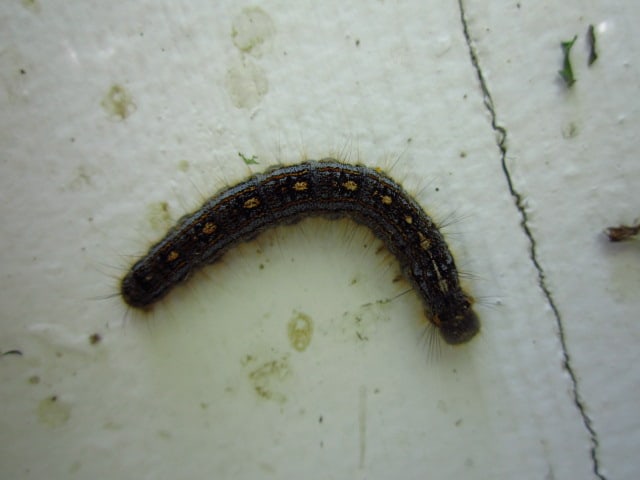In early June I experienced an outbreak of forest tent caterpillars (FTC), Malacosoma disstria, while sampling at an apiary in west-central Minnesota. Not only were the hive lids covered with frass, the technical term for insect feces, but the caterpillars themselves were falling on both the lids and my shoulders as I worked. According to the Minnesota Department of Natural Resources, FTC has been in the outbreak stage in west-central counties of Minnesota for several years, potentially numbering from one to four million caterpillars per acre. In between outbreaks FTC can be nearly undetectable. The larval caterpillars emerge from over-wintered egg masses around mid-May and feed up to the end of June on the leaves of aspen, birch, basswood and oaks, among other hardwoods and shrubs. Although FTC can defoliate thousands of acres of hardwoods the trees mainly suffer from reduced growth, unless other stressors such as a long drought or secondary pest damage come into play. In fact the main complaint seems to be that at outbreak levels FTC is simply a nuisance, falling on recreationists, congregating on the sides of buildings and feeding on ornamentals.

FTC outbreaks always work themselves out, however, with up to 95% dying of starvation, a classic outcome of a species exceeding the carrying capacity of its habitat. As FTC is native to North America the caterpillars have evolved with native predators and parasites. With outbreak levels of FTC come high numbers of Sarcophaga aldrichi, commonly known as the friendly fly. As FTC outbreaks are kept in check by the natural controls of habitat limitation, parasites and predators, the Minnesota DNR does not recommend insecticide treatments. Having just learned of the spread of the invasive Emerald Ash Borer to the south-easternmost counties in Minnesota, it is refreshing to have witnessed a part of the life cycle of a native insect that, while it can reach outbreak levels, can be suppressed by natural control systems. For more information on the forest tent caterpillar visit: http://www.dnr.state.mn.us/treecare/forest_health/ftc/index.html